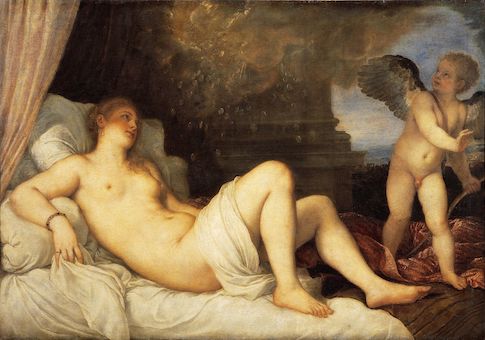To be born a Farnese in 16th Century Italy was to come into this world with certain advantages. The vast wealth of the Farnese, who had been politically and economically active in the northern part of Italy for centuries, guaranteed influence, culminating in 1534 with the election of a Farnese pope, Paul III. Paul had been elevated to the leadership of the Holy See at the peak of an ecclesiastical career that began when his sister Guilia persuaded her lover, the Borgia Pope Alexander VI, to make him a cardinal.
A family man, upon being confirmed pontiff Paul III wasted no time in sharing his good fortune, and appointed his grandson Alessandro Farnese to a cardinalship two months later. Alessandro was 14 years old.
The Farnese enjoyed the good life, foreshadowing by a good four centuries Kipling’s observation that Four things greater than all things are / Women and Horses and Power and War. Alessandro certainly had plenty of all four, and also liked to have pictures of them. A patron of the arts, he was instrumental in attracting the Venetian painter Titian to Rome for a year’s service to the papal family, painting their portraits (enthused by the promise of handsome compensation, Titian reportedly even offered to paint their cats) and executing other subjects of interest.

So came into being Titian’s Danaë, on view through Nov. 6 at the National Gallery in Washington, D.C. It is an example of erotic mythology, a genre that the pamphlet for the exhibition boldly claims Titian "established" in Renaissance painting. (Perhaps, though his teacher Giorgione and older contemporary Michelangelo certainly took part in any such establishment.) One of several paintings Titian made of the myth, Danaë depicts the moment, related by Ovid, in which Zeus impregnates the daughter of Acrisius by infiltrating the tower where she has been imprisoned in the form of a shower of golden coins.

Danaë had been imprisoned by her father upon his having received a prophecy that her child would kill him. Indeed, Perseus is born of the divine encounter, and later goes on to kill—accidentally, as it happens—Acrisius. Perhaps the Farnese enjoyed such subjects because the sexual intrigues and brutal politics of Greek religion so resembled the realities of their own lives.
There was another reason, too, at least when it came to pictures of beautiful girls. X-ray analysis of Danaë reveals that early drafts of the painting set the subject not in a rather impossible looking tower, but in an entirely realistic domestic interior. Young Eros—who, in the finished version, looks on at the divine union in shock—was not present, and in his place in the earlier draft were maidservants and a little dog.
Based on this evidence, it seems that Danaë began her career not as a mythological figure but as an erotic portrait. At some point in the drafting, the elements of Greek religion were added, classing up the painting and, perhaps, making it acceptable for a Europe that was growing increasingly unimpressed with the licentious behavior of its religious leadership. Even so, a letter sent to Alessandro by an associate who saw the painting being worked on in Venice jokes that Titian is happy to give Danae the face of the cardinal’s mistress, should he want.
Centuries passed, family wealth was subsumed in the rise of nationalism, and the painting ended up in a museum in Naples. With the onset of World War II, it was spirited away for safekeeping to the Abbey in Montecassino—an epically poor choice, as it turned out. The Germans helpfully looted the place before it was blown to smithereens by the Allies in 1944, and in January of that year, Danaë was given as a birthday gift to none other than Hermann Goering.
Goering styled himself as a brash man of culture who, like the Farnese before him, also enjoyed the good things in life. The Reichsmarschall enthusiastically participated in the fad of art collection that Adolf Hitler established as a social requirement for senior Nazis, and Danaë, with its old master provenance, mythological subject, and titillating portrayal of a young woman, suited him perfectly. According to Rodolfo Silvero, the Italian government minister who after the war had the task of restoring Italy’s art to Italy, Goering had this, one of Titian’s great masterpieces, hung initially on the ceiling above his bed, and then later placed it at its foot. There is no better commentary on the character of the man.
Before the Allies seized Germany, Danaë was again taken away for safekeeping, this time to the salt mines at Alt Aussee in Austria, where it was nearly destroyed by Nazi functionaries who dreaded the art falling back into the hands of international Jewry. Recovered by American monument officers—recently made prominent by an unfortunately non-excellent George Clooney film—the painting ultimately returned to Naples.
That it is again—it was here for a Titian retrospective some years ago—on display in Washington is especially fitting. Saved by American officers in the war, it now hangs near Titian’s portrait of Alessandro’s younger brother Ranuccio, as well as two other erotic mythologies painted by Titian—Venus and Adonis and the stunning Venus with a Mirror.

And though it represents a decidedly humanist turn in painting, its subject—the union of a woman and God, followed by the birth of a divine hero—is also in evidence all around it at the National Gallery: for such a subject is also what the NGA’s fine collection of Marian annunciation scenes depict.

These scenes represent the Christian vision of humans, through their faith, made godly. Titian—like the Farnese, and Goering too—was more interested in the pagan conception of gods, in their venality, behaving in ways that were all too human.
